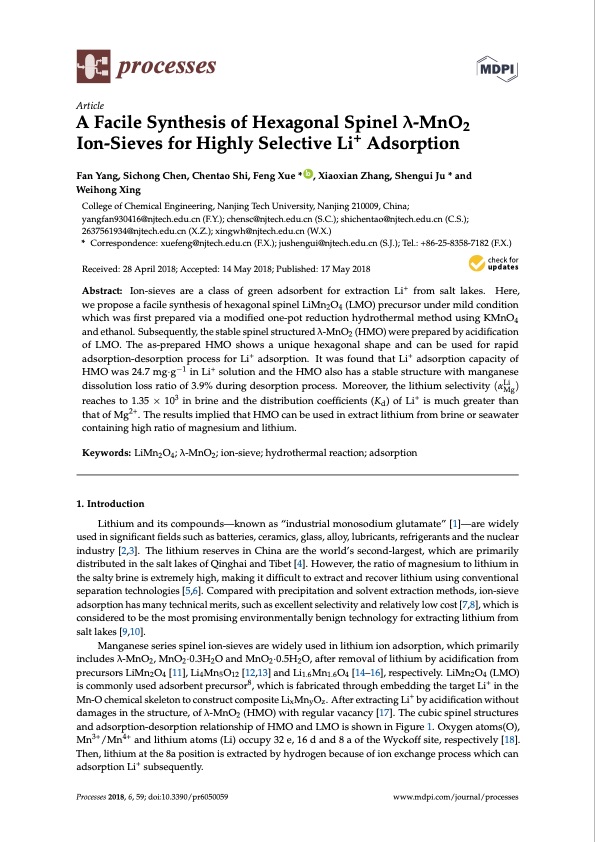
PDF Publication Title:
Text from PDF Page: 001
processes Article A Facile Synthesis of Hexagonal Spinel λ-MnO2 Ion-Sieves for Highly Selective Li+ Adsorption Fan Yang, Sichong Chen, Chentao Shi, Feng Xue * ID , Xiaoxian Zhang, Shengui Ju * and Weihong Xing College of Chemical Engineering, Nanjing Tech University, Nanjing 210009, China; yangfan930416@njtech.edu.cn (F.Y.); chensc@njtech.edu.cn (S.C.); shichentao@njtech.edu.cn (C.S.); 2637561934@njtech.edu.cn (X.Z.); xingwh@njtech.edu.cn (W.X.) * Correspondence:xuefeng@njtech.edu.cn(F.X.);jushengui@njtech.edu.cn(S.J.);Tel.:+86-25-8358-7182(F.X.) Received: 28 April 2018; Accepted: 14 May 2018; Published: 17 May 2018 Abstract: Ion-sieves are a class of green adsorbent for extraction Li+ from salt lakes. Here, we propose a facile synthesis of hexagonal spinel LiMn2O4 (LMO) precursor under mild condition which was first prepared via a modified one-pot reduction hydrothermal method using KMnO4 and ethanol. Subsequently, the stable spinel structured λ-MnO2 (HMO) were prepared by acidification of LMO. The as-prepared HMO shows a unique hexagonal shape and can be used for rapid adsorption-desorption process for Li+ adsorption. It was found that Li+ adsorption capacity of HMO was 24.7 mg·g−1 in Li+ solution and the HMO also has a stable structure with manganese dissolution loss ratio of 3.9% during desorption process. Moreover, the lithium selectivity (αLi ) Mg reaches to 1.35 × 103 in brine and the distribution coefficients (Kd) of Li+ is much greater than that of Mg2+. The results implied that HMO can be used in extract lithium from brine or seawater containing high ratio of magnesium and lithium. Keywords: LiMn2O4; λ-MnO2; ion-sieve; hydrothermal reaction; adsorption 1. Introduction Lithium and its compounds—known as “industrial monosodium glutamate” [1]—are widely used in significant fields such as batteries, ceramics, glass, alloy, lubricants, refrigerants and the nuclear industry [2,3]. The lithium reserves in China are the world’s second-largest, which are primarily distributed in the salt lakes of Qinghai and Tibet [4]. However, the ratio of magnesium to lithium in the salty brine is extremely high, making it difficult to extract and recover lithium using conventional separation technologies [5,6]. Compared with precipitation and solvent extraction methods, ion-sieve adsorption has many technical merits, such as excellent selectivity and relatively low cost [7,8], which is considered to be the most promising environmentally benign technology for extracting lithium from salt lakes [9,10]. Manganese series spinel ion-sieves are widely used in lithium ion adsorption, which primarily includes λ-MnO2, MnO2·0.3H2O and MnO2·0.5H2O, after removal of lithium by acidification from precursors LiMn2O4 [11], Li4Mn5O12 [12,13] and Li1.6Mn1.6O4 [14–16], respectively. LiMn2O4 (LMO) is commonly used adsorbent precursor8, which is fabricated through embedding the target Li+ in the Mn-O chemical skeleton to construct composite LixMnyOz. After extracting Li+ by acidification without damages in the structure, of λ-MnO2 (HMO) with regular vacancy [17]. The cubic spinel structures and adsorption-desorption relationship of HMO and LMO is shown in Figure 1. Oxygen atoms(O), Mn3+/Mn4+ and lithium atoms (Li) occupy 32 e, 16 d and 8 a of the Wyckoff site, respectively [18]. Then, lithium at the 8a position is extracted by hydrogen because of ion exchange process which can adsorption Li+ subsequently. Processes 2018, 6, 59; doi:10.3390/pr6050059 www.mdpi.com/journal/processesPDF Image | Sieves for Highly Selective Li Adsorption

PDF Search Title:
Sieves for Highly Selective Li AdsorptionOriginal File Name Searched:
processes-06-00059-v2.pdfDIY PDF Search: Google It | Yahoo | Bing
Product and Development Focus for Infinity Turbine
ORC Waste Heat Turbine and ORC System Build Plans: All turbine plans are $10,000 each. This allows you to build a system and then consider licensing for production after you have completed and tested a unit.Redox Flow Battery Technology: With the advent of the new USA tax credits for producing and selling batteries ($35/kW) we are focussing on a simple flow battery using shipping containers as the modular electrolyte storage units with tax credits up to $140,000 per system. Our main focus is on the salt battery. This battery can be used for both thermal and electrical storage applications. We call it the Cogeneration Battery or Cogen Battery. One project is converting salt (brine) based water conditioners to simultaneously produce power. In addition, there are many opportunities to extract Lithium from brine (salt lakes, groundwater, and producer water).Salt water or brine are huge sources for lithium. Most of the worlds lithium is acquired from a brine source. It's even in seawater in a low concentration. Brine is also a byproduct of huge powerplants, which can now use that as an electrolyte and a huge flow battery (which allows storage at the source).We welcome any business and equipment inquiries, as well as licensing our turbines for manufacturing.| CONTACT TEL: 608-238-6001 Email: greg@infinityturbine.com | RSS | AMP |